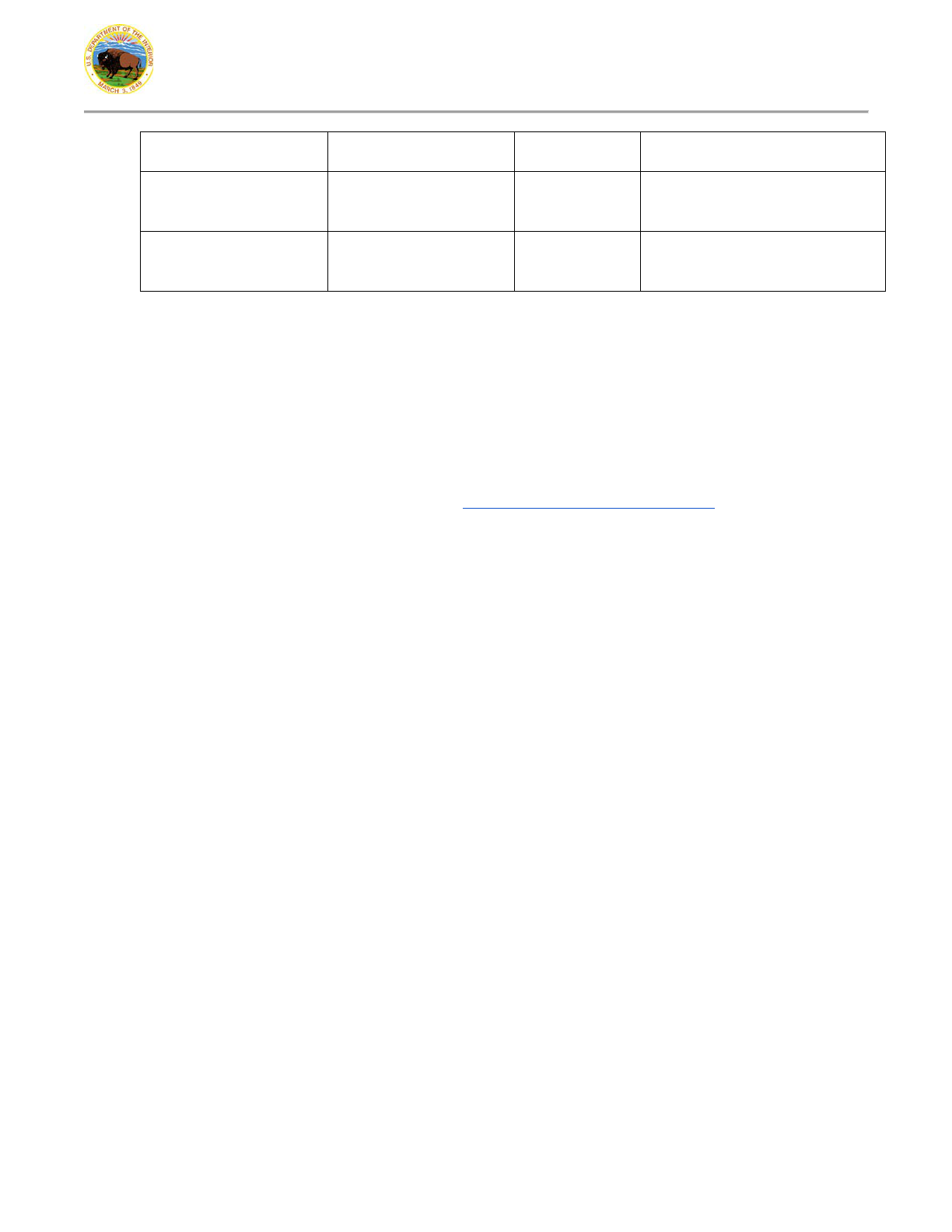
U.S. Department of the Interior
PRIVACY IMPACT ASSESSMENT
Introduction
The Department of the Interior requires PIAs to be conducted and maintained on all IT systems whether
already in existence, in development or undergoing modification in order to adequately evaluate privacy
risks, ensure the protection of privacy information, and consider privacy implications throughout the
information system development life cycle. This PIA form may not be modified and must be completed
electronically; hand-written submissions will not be accepted. See the DOI PIA Guide for additional
guidance on conducting a PIA or meeting the requirements of the E-Government Act of 2002. See
Section 6.0 of the DOI PIA Guide for specific guidance on answering the questions in this form.
NOTE: See Section 7.0 of the DOI PIA Guide for guidance on using the DOI Adapted PIA template to
assess third-party websites or applications.
Name of Project: eMail Enterprise Records Document Management System (eERDMS)
Bureau/Office: Office of the Secretary
Date: September 30, 2019
Point of Contact
Name: Teri Barnett
Title: Departmental Privacy Officer
Phone: 202-208-1605
Address: 1849 C Street NW, Room 7112, Washington, DC 20240
Section 1. General System Information
A. Is a full PIA required?
☒ Yes, information is collected from or maintained on
☐ Members of the general public
☐ Federal personnel and/or Federal contractors
☐ Volunteers
☒ All
☐ No: Information is NOT collected, maintained, or used that is identifiable to the individual in
this system. Only sections 1 and 5 of this form are required to be completed.
B. What is the purpose of the system?
The Department of the Interior (DOI) eMail Enterprise Records Document Management System
(eERDMS) helps DOI meet its objective to identify, acquire and deploy an enterprise application
that combines electronic workflow, imaging, and management of documents, e-mails, discovery,

eMail Enterprise Records Document Management System (eERDMS)
Privacy Impact Assessment
2
and records. eERDMS provides the framework for enterprise use for storing, accessing, and
managing the DOI’s records, regardless of format, media, source or location.
eERDMS is a major application that includes five sub-applications: Enterprise eArchive System
(EES), Enterprise Content System (ECS), Early Case Assessment (ECA), Advanced Early Case
Assessment (AECA) and OpenText Auto-Classification (OTAC). The EES, ECS, ECA, and
AECA components contain personally identifiable information (PII) and the privacy implications
for these components are assessed in this privacy impact assessment.
● EES provides a Department-wide email archival and document management capability to
allow the Department to retain and protect email communication for the appropriate
retention periods and to ensure that past and future emails and email attachments will be
reliably, consistently and automatically captured, archived, and retained in a safe and
secure environment.
● ECS manages non-email electronic content in support of the records management
initiatives of DOI with an online centralized electronic document archive.
● ECA and AECA work together to manage collections created within ECS to support
OMB Circular A-130 areas, e-Discovery, and internal investigations.
● OTAC is a component that temporarily pulls data from EES to process data. The only
data that is stored in OTAC are statistical information and EES DataIDs.
The EES, ECS, and ECA/AECA in eERDMS provide the framework for storing, accessing, and
managing the Department’s records. DOI employees will have access to electronic records and
documentation through a web browser to create, access and share information. As the rate of
Information Technology (IT) change accelerates, there are increasing concerns about the
government’s ability to manage and preserve its records and to meet accountability and archival
obligations. Using eERDMS as an enterprise solution allows DOI to address program specific
concerns such as preventing the loss of records that should be kept for legal and accountability
purposes, achieving confidence in the authenticity and reliability of records, eliminating
confusion between record versions, maintaining context to understand records properly, and
controlling and planning for technological change that could make records inaccessible or
incomprehensible.
C. What is the legal authority?
● The Paperwork Reduction Act, 44 U.S.C. 3501
● The Clinger-Cohen Act of 1996, 40 U.S.C. 1401
● 36 CFR 1220: Federal Records, General
● OMB Circular A-130, Managing Information as a Strategic Resource
● Executive Order 13571, Streamlining Service Delivery and Improving Customer Service
● Presidential Memorandum, Security Authorization of Information Systems in Cloud
Computing Environments
● Presidential Memorandum, Building a 21st Century Digital Government
● OMB M-12-18, Managing Government Records
● Presidential Memorandum, Managing Government Records

eMail Enterprise Records Document Management System (eERDMS)
Privacy Impact Assessment
3
D. Why is this PIA being completed or modified?
☐ New Information System
☐ New Electronic Collection
☒ Existing Information System under Periodic Review
☐ Merging of Systems
☐ Significantly Modified Information System
☐ Conversion from Paper to Electronic Records
☐ Retiring or Decommissioning a System
☐ Other: Describe
E. Is this information system registered in CSAM?
☒ Yes: Enter the UII Code and the System Security Plan (SSP) Name
010-000001728; eMail Enterprise Records and Document and Management System (eERDMS)
SSP
☐ No
F. List all minor applications or subsystems that are hosted on this system and covered under
this privacy impact assessment.
Subsystem Name
Purpose
Contains PII
(Yes/No)
Describe
If Yes, provide a description.
Enterprise eArchive
System (EES)
EES provides a
Department-wide email
archival and document
management capability
to allow the Department
to retain and protect
email communication
for the appropriate
retention periods and to
ensure that past and
future emails and email
attachments will be
reliably, consistently
and automatically
captured, archived and
retained in a safe and
secure environment.
Yes
Name, Personal Email of Email
Sender and recipients, Personal
Phone Number, Personal
Address, Social Security
Number, Tribal Identification
Number, Date of Birth, Credit
Card Number, Driver License
Number, Vehicle Identification
Number, License Plate Number,
Identification Badge Data,
Financial Information, Medical
Information, Disability Status,
Ethnicity, Race, Nationality,
Physical or Distinguishing
Attributes, Photos, Spouse or
Dependent Information, Passport
Number, Gender, Fingerprints,
Hair and Eye Color, Biometric
Data and other information
found in email correspondence
generated, maintained and

eMail Enterprise Records Document Management System (eERDMS)
Privacy Impact Assessment
4
Subsystem Name
Purpose
Contains PII
(Yes/No)
Describe
If Yes, provide a description.
received during the transactions
and work activities of DOI
bureaus, offices and programs.
Enterprise Content
System (ECS)
ECS is used to manage
online content in
support of the records
management initiatives
of DOI with an online
centralized electronic
and document content
capture and mobility
management solution.
Yes
Name, Citizenship, Gender,
Birth Date, Marital Status, Other
Names Used, Truncated SSN,
Legal Status, Place of Birth,
Security Clearance, Spouse
Information, Financial
Information, Medical
Information, Disability
Information, Credit Card
Number, Law Enforcement,
Education Information,
Emergency Contact, Driver’s
License, Race/Ethnicity, Social
Security Number (SSN),
Personal Cell Telephone
Number, Tribal or Other ID
Number, Personal Email
Address, Mother’s Maiden
Name, Home Telephone
Number, Child or Dependent
Information, Employment
Information, Military
Status/Service and
Mailing/Home Address
Early Case Assessment
(ECA)/Advanced Early
Case Assessment
(AECA)
ECA manages
collections created
within ECS to support
A-130 areas, e-
Discovery and internal
investigations.
AECA is used to
perform deep analysis
of collections from the
ECA process.
Yes
Name, Personal Email of Email
Sender and recipients, Personal
Phone Number, Personal
Address, Social Security
Number, Tribal Identification
Number, Date of Birth, Credit
Card Number, Driver License
Number, Vehicle Identification
Number, License Plate Number,
Identification Badge Data,
Financial Information, Medical
Information, Disability Status,
Ethnicity, Race, Nationality,
Physical or Distinguishing
Attributes, Photos, Spouse or
Dependent Information, Passport
Number, Gender, Fingerprints,
Hair and Eye Color, Biometric
Data and other information
found in email correspondence
generated, maintained and

eMail Enterprise Records Document Management System (eERDMS)
Privacy Impact Assessment
5
Subsystem Name
Purpose
Contains PII
(Yes/No)
Describe
If Yes, provide a description.
received during the transactions
and work activities of DOI
bureaus, offices and programs.
OpenText Auto-
Classification (OTAC)
OTAC pulls in data
from EES temporarily
to process statistics.
No
G. Does this information system or electronic collection require a published Privacy Act
System of Records Notice (SORN)?
☒ Yes: List Privacy Act SORN Identifier(s)
OS-10, Electronic Email Archive System (EEAS), 68 FR 4220 (January 28, 2003); modification
published 73 FR 8342 (February 13, 2008). Due to the nature of eERDMS as DOI’s enterprise
records management system, records may be covered by Government-wide or DOI Privacy Act
system of records which may be viewed at https://www.doi.gov/privacy/sorn.
☐ No
H. Does this information system or electronic collection require an OMB Control Number?
☐ Yes: Describe
☒ No
Section 2. Summary of System Data
A. What PII will be collected? Indicate all that apply.
☒ Name
☒ Citizenship
☒ Gender
☒ Birth Date
☒ Group Affiliation
☒ Marital Status
☒ Biometrics
☒ Other Names Used
☒ Truncated SSN
☒ Legal Status
☒ Place of Birth
☒ Religious Preference

eMail Enterprise Records Document Management System (eERDMS)
Privacy Impact Assessment
6
☒ Security Clearance
☒ Spouse Information
☒ Financial Information
☒ Medical Information
☒ Disability Information
☒ Credit Card Number
☒ Law Enforcement
☒ Education Information
☒ Emergency Contact
☒ Driver’s License
☒ Race/Ethnicity
☒ Social Security Number (SSN)
☒ Personal Cell Telephone Number
☒ Tribal or Other ID Number
☒ Personal Email Address
☒ Mother’s Maiden Name
☒ Home Telephone Number
☒ Child or Dependent Information
☒ Employment Information
☒ Military Status/Service
☒ Mailing/Home Address
☒ Other: Specify the PII collected.
Due to the nature of eERDMS as DOI’s enterprise records management system, records may
include various types of PII or other information about individuals that is contained in DOI
records. EES and ECS may collect any PII that a user chooses to include in an email or other
electronic document that is stored for recordkeeping purposes. ECA/AECA are copies of
documents pulled from EES, ECS or other sources which are used for document production
purposes like Congressional Inquiries, Litigation Support, Freedom of Information Act (FOIA),
etc.
B. What is the source for the PII collected? Indicate all that apply.
☒ Individual
☒ Federal agency
☒ Tribal agency
☒ Local agency
☒ DOI records
☒ Third party source
☒ State agency
☒ Other: Describe

eMail Enterprise Records Document Management System (eERDMS)
Privacy Impact Assessment
7
EES and ECS may collect any PII that a user chooses to include in an email or other electronic
document that is stored for record keeping purposes. ECA/AECA are copies of documents
pulled from EES, ECS or other sources which are used for document production purposes like
Congressional Inquiries, Litigation Support, FOIA, etc.
C. How will the information be collected? Indicate all that apply.
☒ Paper Format
☒ Email
☐ Face-to-Face Contact
☒ Web site
☐ Fax
☐ Telephone Interview
☒ Information Shared Between Systems
☒ Other: Describe
EES and ECS may collect any PII that a user chooses to include in an email or other electronic
document that is stored for record keeping purposes. ECA/AECA are copies of documents
pulled from EES, ECS or other sources which are used for document production purposes like
Congressional Inquiries, Litigation Support, FOIA, etc.
D. What is the intended use of the PII collected?
The purpose of eERDMS is to provide a framework for enterprise use for storing, accessing, and
managing the DOI’s records. eERDMS allows DOI to address program specific concerns such
as preventing the loss of records that should be kept for legal and accountability purposes,
achieving confidence in the authenticity and reliability of records, eliminating confusion between
record versions, maintaining context to understand records properly, and controlling and
planning for technological change that could make records inaccessible or incomprehensible. PII
contained in these records may be used as part of or in support of records management or records
keeping purposes, to support audits, discovery, email and document management, and document
production purposes like Congressional Inquiries, FOIA and litigation support.
E. With whom will the PII be shared, both within DOI and outside DOI? Indicate all that
apply.
☒ Within the Bureau/Office: Describe the bureau/office and how the data will be used.
The Office of the Chief Information Officer (OCIO) manages and maintains the eERDMS
system. The Departmental Records Officer within the OCIO has access to all the records within
the system, and may share information as requested.

eMail Enterprise Records Document Management System (eERDMS)
Privacy Impact Assessment
8
EES and ECS may collect any PII that a user chooses to include in an email or other electronic
document that is stored for record keeping purposes. Each bureau designates specific individuals
records management functions that have access to these systems.
ECA/AECA are copies of documents pulled from EES, ECS or other sources which are used for
document production purposes like Congressional Inquiries, Litigation Support, FOIA, etc. The
Office of the Executive Secretariat and the Office of the Solicitor review document collections to
determine what needs to be redacted and what is appropriate for release depending on the
specific request.
☒ Other Bureaus/Offices: Describe the bureau/office and how the data will be used.
EES and ECS may collect any PII that a user chooses to include in an email or other electronic
document that is stored for record keeping purposes. Each bureau designates specific individuals
records management functions that have access to these systems.
ECA/AECA are copies of documents pulled from EES, ECS or other sources which are used for
document production purposes like Congressional Inquiries, Litigation Support, FOIA, etc. The
Office of the Executive Secretariat and the Office of the Solicitor review document collections to
determine what needs to be redacted and what is appropriate for release depending on the
specific request.
PII is shared with DOI employees, contractors, and volunteers who access the system through
their DOI Active Directory account and is used to report key statistical transactional data related
to eERDMS.
☒ Other Federal Agencies: Describe the federal agency and how the data will be used.
Other Federal Agencies do not access EES/ECS directly. However, ECA/AECA are copies of
documents pulled from EES, ECS or other sources which are used for document production
purposes like Congressional Inquiries, Litigation Support, FOIA, etc. The Office of the
Executive Secretariat and the Office of the Solicitor review document collections to determine
what needs to be redacted and what is appropriate for release depending on the specific request.
Information may be shared with other Federal agencies as authorized and required to meet legal
and reporting requirements.
☒ Tribal, State or Local Agencies: Describe the Tribal, state or local agencies and how the data
will be used.
Tribal, State, or Local Agencies do not access EES/ECS directly. ECA/AECA are copies of
documents pulled from EES, ECS or other sources which are used for document production
purposes like Congressional Inquiries, Litigation Support, FOIA, etc. The Office of the
Executive Secretariat and the Office of the Solicitor review document collections to determine
what needs to be redacted and what is appropriate for release depending on the specific request.

eMail Enterprise Records Document Management System (eERDMS)
Privacy Impact Assessment
9
☒ Contractor: Describe the contractor and how the data will be used.
Information may be shared with contractors who provide support for these program activities.
☒ Other Third Party Sources: Describe the third party source and how the data will be used.
Any information provided to other sources from eERDMS will go through the DOI FOIA
process prior to being released. PII and other sensitive information will be redacted by the FOIA
team.
F. Do individuals have the opportunity to decline to provide information or to consent to the
specific uses of their PII?
☐ Yes: Describe the method by which individuals can decline to provide information or how
individuals consent to specific uses.
☒ No: State the reason why individuals cannot object or why individuals cannot give or
withhold their consent.
eERDMS is a records management system and does not collect PII directly from the individual.
The eERDMS components do not provide individuals with an opportunity to decline to provide
information in the records management process.
G. What information is provided to an individual when asked to provide PII data? Indicate
all that apply.
☐ Privacy Act Statement: Describe each applicable format.
☒ Privacy Notice: Describe each applicable format.
Notice is provided to individuals through the publication of this privacy impact assessment and
the related systems of records notices published in the Federal Register.
☐ Other: Describe each applicable format.
☐ None
H. How will the data be retrieved? List the identifiers that will be used to retrieve information
(e.g., name, case number, etc.).
EES, ECS, and ECA/AECA data may be retrieved using various types of keyword searches. The
search criteria used will depend on specific search needs, but may include personal identifiers
such as name and email address. Other personal identifiers may also be used, at the discretion of
the individual performing the search. When retrieving data all requests go through an audit

eMail Enterprise Records Document Management System (eERDMS)
Privacy Impact Assessment
10
request form process with management approvals that ensure the searches are within appropriate
need and scope.
● EES - Date range, sender or recipient email address or key word search
● ECS - metadata driven based on type of document stored, e.g., document number or title
● ECA/AECA - contents are driven by documents pulled from EES or ECS, e.g., date
range, sender or recipient email address, keyword search, document number or title
I. Will reports be produced on individuals?
☒ Yes: What will be the use of these reports? Who will have access to them?
EES, ECS, and ECA/AECA are enterprise-wide content management systems that are used for
content and document management and assist the Department in complying with Federal
recordkeeping requirements, responding to FOIA requests and Congressional requests for
information, and responding to electronic discovery actions. Subject to regulations limiting the
disclosure of information, reports that support the purposes listed in the previous paragraph may
be produced concerning documents created by an individual or documents that include personal
information about the individual, as well as, emails sent or received by an individual.
Audit reports can be produced to review the actions of authorized system users to determine if
their use of the EES, ECS, and ECA/AECA systems and the data has been in accordance with all
rules and procedures for the system. Only users with elevated rights can run audit reports.
Statistical reports generated for system maintenance generally do not contain sensitive PII.
☐ No
Section 3. Attributes of System Data
A. How will data collected from sources other than DOI records be verified for accuracy?
eERDMS is an enterprise records management system that captures the records of the
Departement and relies on the sourcing systems and processes to ensure that the information
provided is accurate. Otherwise, documents captured are intended to be duplicates of the
originals, and are not otherwise checked for accuracy.
B. How will data be checked for completeness?
eERDMS is an enterprise records management system that captures the records of the
Departement and relies on the sourcing systems and processes to ensure that the information
provided is complete. Otherwise, documents captured are intended to be duplicates of the
originals, and are not otherwise checked for completeness.

eMail Enterprise Records Document Management System (eERDMS)
Privacy Impact Assessment
11
C. What procedures are taken to ensure the data is current? Identify the process or name the
document (e.g., data models).
eERDMS is an enterprise records management system that captures the records of the
Departement and relies on the sourcing systems and processes to ensure that the information
provided is current. Otherwise, documents captured are intended to be duplicates of the
originals, and are not otherwise checked for currency. Since eERDMS is a record keeping
system, by definition, some of the information retained in various components is historical and
not current due to the requirements of the Federal Record Act.
D. What are the retention periods for data in the system? Identify the associated records
retention schedule for the records in this system.
Retention periods for records captured by eERDMS or any of the components vary according to
agency needs and specific subject matter, and are retained in accordance with applicable
Departmental Records Schedule (DRS) authorities, as approved by the National Archives and
Records Administration (NARA). Some records are currently treated as “unscheduled” while
the applicable DRS component is awaiting NARA approval, and must be treated as permanent
records until the DRS items are approved. Records retention periods may also be suspended by
litigation holds, court orders, preservation notices, and similar issued by the Office of the
Solicitor, the DOI or Bureau Records Officer, or other authorized official.
System administrator logs are covered by DRS 1.4.0013, System Maintenance and Use Records
(DAA-0048-2013-0001-0013). These records have a temporary disposition and are cut off when
superseded or obsolete. Records are destroyed no later than 3 years after cut-off.
Data in ECA/AECA is maintained under DRS 1.1.0003, Administration Records of Specific
Temporary Value (DAA-0048-2013-0001-0003). These records have a temporary disposition
and are cut off when the object or subject the records refer to is removed/discontinued/obsolete.
Records are destroyed when no longer needed.
E. What are the procedures for disposition of the data at the end of the retention period?
Where are the procedures documented?
With EES and ECS, records are disposed of in accordance with the applicable Departmental
Records Schedule disposition authority, Departmental policy and referenced NARA guidelines.
EES and ECS include the ability to automatically notify records managers about records that
have passed their disposition date. These disposition reports allow for individual review and
processing decision (carry out the destruction action). When records are disposed of via
disposition, a Department of Defense secure delete is performed on the records. Unscheduled
records will be maintained as permanent records within the system and cannot be destroyed until
the DRS items are approved by NARA. Permanent records will be transferred to NARA for
ongoing retention at their appropriate disposition time.

eMail Enterprise Records Document Management System (eERDMS)
Privacy Impact Assessment
12
ECA/AECA do not have an automated retention functionality. Since ECA/AECA are used for
document production purposes all records contained in these systems are considered copies of
the original and need to be maintained for as long as the Congressional inquiry, FOIA request,
litigation, or other oversight request remains active.
F. Briefly describe privacy risks and how information handling practices at each stage of the
“information lifecycle” (i.e., collection, use, retention, processing, disclosure and
destruction) affect individual privacy.
eERDMS primary privacy risks include unauthorized access, unauthorized disclosure and misuse
of the data in the system. These risks are addressed and mitigated through a variety of
administrative and logical security controls. When retrieving data all requests go through an
audit request form process with management approvals that ensure the searches are within
appropriate need and scope.
User access is granted only to authorized individuals by system administrators, and users are
granted access only to the data sets needed in order to perform their job duties; data set access is
also governed and limited by each user’s email domain. Only authorized users are provided
access to eERDMS using single sign-on and validated through the DOI Active Directory.
Administrative access to EES, ECS, and ECA/AECA is granted only to authorized personnel on
an official need-to-know basis. Unique administrator identification and authentication, least
privileges and audit logs are utilized to ensure appropriate permissions and access levels. In
many cases, administrators can be granted adequate rights to fulfill their duties without being
given access to data in the system.
All users of DOI network resources, including contractors, must consent to rules of behavior and
take annual end-user security, privacy and records training in order to obtain access to any DOI
network resource. EES, ECS, and ECA/AECA administrators are also required to take computer
security and privacy role-based training.
EES, ECS, ECA, and AECA have a hierarchical administration consisting of a Lead
Administrator, and multiple Support Administrators who supervise administrators at the
Department level, as well as DOI bureaus and offices. Bureau and Office Records Officers are
responsible for controlling and monitoring access of authorized records staff who are given
access to data for their Bureau or Office. Bureau/Office Administrators and authorized
employees are only granted access to documents and data in EES, ECS, ECA, and AECA to the
extent it is necessary for the performance of their job duties. Access procedures are further
described in the eERDMS System Authorization and Accreditation (A&A) documentation and
the system security plan.
Audit logs, access level restrictions, and least privileges are used to ensure users have access
only to the data they are authorized to view, which serves as a control on unauthorized
monitoring. In addition, firewalls and network security arrangements are built into the
architecture of the system, and NIST guidelines and Departmental policies are implemented to
ensure system and data security. System administrators will review the activities of the users to
ensure that the system is not improperly used, including for unauthorized monitoring.

eMail Enterprise Records Document Management System (eERDMS)
Privacy Impact Assessment
13
Access is restricted to only those individuals authorized by System Administrators on a need to
know basis in order to perform their job duties consistent with the purposes of the system. This
includes limiting authorized individuals’ access to selected repositories of documents and data
within the system, such as the authorized individual’s bureau or office. Limitations on access are
maintained through user login and authentication.
There is a risk that data from different sources may be aggregated and may provide more
information about an individual. This data may become outdated or inaccurate. Mitigation occurs
at the time of entry through data validation. Records are disposed based upon the records
management schedule.
There is a risk that data may not be appropriate to store in a cloud service provider’s system, or
that the vendor may not handle or store information appropriately according to DOI policy. The
provider will implement protections and controls to restrict access to unauthorized parties, as will
be required to attain the necessary FedRAMP Authority to Operate (ATO). The provider will be
required to submit security accreditation to attain the DOI ATO to ensure the vendor’s system
handles and stores sensitive information in accordance with Federal and DOI privacy and
security standards.
There is a risk that individuals may not have notice regarding the collection of information, the
purposes for collection or how the information will be used. Notice is provided through the
publication of this privacy impact assessment.
The user traceability program can detect and through ad-hoc capabilities report unauthorized
access attempts to files outside of an authorized user’s permissions. The audit logs for the
eERDMS components may be used to run reports on individual users’ access to and actions
within the system. The user traceability program can detect and report unauthorized access
attempts to files outside of an authorized user’s permissions.
With EES, due to the high volume of documents being added to EES, the system utilizes auto-
classification technologies to classify and categorize email journaled to the solution. While this
is a new technology, processes are being put in place so that statistical data and samples are
reviewed by bureau records officers to ensure the auto-classification is maintained in as accurate
a manner as possible.
Section 4. PIA Risk Review
A. Is the use of the data both relevant and necessary to the purpose for which the system is
being designed?
☒ Yes: Explanation
eERDMS enables DOI to manage and preserve its records and to meet accountability and
archival obligations under the Federal Records Act. eERDMS allows DOI to address program

eMail Enterprise Records Document Management System (eERDMS)
Privacy Impact Assessment
14
specific concerns such as preventing the loss of records that should be kept for legal and
accountability purposes, achieving confidence in the authenticity and reliability of records,
eliminating confusion between record versions, maintaining context to understand records
properly, and controlling and planning for technological change that could make records
inaccessible or incomprehensible.
☐ No
B. Does this system or electronic collection derive new data or create previously unavailable
data about an individual through data aggregation?
☐ Yes: Explain what risks are introduced by this data aggregation and how these risks will be
mitigated.
☒ No
C. Will the new data be placed in the individual’s record?
☐ Yes: Explanation
☒ No
D. Can the system make determinations about individuals that would not be possible without
the new data?
☐ Yes: Explanation
☒ No
E. How will the new data be verified for relevance and accuracy?
Not applicable. eERDMS is a records and document management system that captures the
records of the Department and will not derive new data or create previously unavailable data.
F. Are the data or the processes being consolidated?
☐ Yes, data is being consolidated. Describe the controls that are in place to protect the data
from unauthorized access or use.
☐ Yes, processes are being consolidated. Describe the controls that are in place to protect the
data from unauthorized access or use.
☒ No, data or processes are not being consolidated.

eMail Enterprise Records Document Management System (eERDMS)
Privacy Impact Assessment
15
G. Who will have access to data in the system or electronic collection? Indicate all that apply.
☒ Users
☒ Contractors
☒ Developers
☒ System Administrator
☒ Other: Describe
Access to information will be limited to those authorized individuals that have a need to know
the data in order to perform official duties, including system administrators, authorized program
personnel, and contractors based on least privileges.
H. How is user access to data determined? Will users have access to all data or will access be
restricted?
Access level restrictions, authentication, least privileges, and audit logs are used to ensure users
have access only to the data they are authorized to view. Access is further governed by DOI IT
security policy, including use of assigned passwords, limited access rules, various firewalls, and
other protections put in place to ensure the integrity and protection of information. All DOI
employees and contractor employees undergo initial and annual security, privacy and records
management training, and sign DOI Rules of Behavior before being granted access to DOI
networks and information.
EES, ECS, ECA, and AECA have a hierarchical administration consisting of a Lead
Administrator, and multiple Support Administrators who supervise administrators at the
Department level, as well as DOI bureaus and offices. Bureau and Office Records Officers are
responsible for controlling and monitoring access of authorized records staff who are given
access to data for their Bureau or Office. Bureau/Office Administrators and authorized
employees are only granted access to documents and data in EES, ECS, ECA, and AECA to the
extent it is necessary for the performance of their job duties. Access procedures are further
described in the eERDMS System Authorization and Accreditation (A&A) documentation and
the system security plan.
Access is restricted to only those individuals authorized by System Administrators on a need to
know basis in order to perform their job duties consistent with the purposes of the system. This
includes limiting authorized individuals’ access to selected repositories of documents and data
within the system, such as the authorized individual’s bureau or office. Limitations on access are
maintained through user login and authentication.
I. Are contractors involved with the design and/or development of the system, or will they be
involved with the maintenance of the system?
☒ Yes. Were Privacy Act contract clauses included in their contracts and other regulatory
measures addressed?

eMail Enterprise Records Document Management System (eERDMS)
Privacy Impact Assessment
16
Contractors were involved with the design and configuration of the system and will be involved
with the maintenance and operation of the system. Federal Acquisition Regulation (FAR)
contract Clause 52.224-1, Privacy Act Notification (April 1984), FAR contract Clause 52.224-2,
Privacy Act (April 1984), FAR contract Clause 52.239-1, Privacy or Security Safeguards
(August 1996) and 5 U.S.C. 552a are included by reference in the agreement with the contractor.
☐ No
J. Is the system using technologies in ways that the DOI has not previously employed (e.g.,
monitoring software, SmartCards or Caller ID)?
☐ Yes. Explanation
☒ No
K. Will this system provide the capability to identify, locate and monitor individuals?
☒ Yes. Explanation
eERDMS is not intended to monitor individuals. However, the system has the ability to audit
usage of the system, including reviewable data concerning logins, including login time, to protect
against unauthorized access or actions within the system. Audit logs, access level restrictions,
and least privileges are used to ensure users have access only to the data they are authorized to
view, which serves as a control on unauthorized monitoring. In addition, firewalls and network
security arrangements are built into the architecture of the system, and NIST guidelines and
Departmental policies are implemented to ensure system and data security. System
administrators will review the activities of the users to ensure that the system is not improperly
used, including for unauthorized monitoring.
☐ No
L. What kinds of information are collected as a function of the monitoring of individuals?
eERDMS is not intended to monitor individuals. However, the system has the ability to audit
usage of the system, including use by authorized individuals and system administrators. This
includes reviewable data concerning actions within the system, including username, date and
time of day a user accessed the system, specific uniform resource locators (URLs) of component
systems, search terms or parameters used to call data, user creation and deletion of files, user
creation or deletion of user accounts, and changes to account privileges. The user traceability
program can detect and through ad-hoc capabilities report unauthorized access attempts to files
outside of an authorized user’s permissions.
The eERDMS audit logs can be used to run reports on individual users’ access to and actions
within the system, including username, date and time of day a user accessed the system, specific
URLs of system web pages and documents accessed, search terms or parameters used to call data
from the databases, user creation and deletion of files, user creation or deletion of user accounts,
and changes to account privileges. The user traceability program can detect and report
unauthorized access attempts to files outside of an authorized user’s permissions.

eMail Enterprise Records Document Management System (eERDMS)
Privacy Impact Assessment
17
M. What controls will be used to prevent unauthorized monitoring?
eERDMS is administered by Department assigned users and a DOI contractor. The agreement
with the contractor includes by reference Federal Acquisition Regulation (FAR) contract Clause
52.239-1, Privacy or Security Safeguards (Aug 1996). These regulations proscribe privacy
protections including safeguards against unauthorized use of the data and unauthorized
monitoring of individuals. Only authorized users will be able to access the system. In addition,
all users must consent to the DOI Rules of Behavior and complete Federal Information System
Security Awareness, Privacy and Records Management training before being granted access to
the DOI network or any DOI system, and annually thereafter.
Any request to access DOI data made to the contractor supporting the operation or the assigned
Departmental administrator. Access to eERDMS must be approved by the system owner or
designated representative before access can be granted. Audit logs are used to ensure individual
user access and actions are authorized and within the scope of official duties, and the user
traceability program can detect and report unauthorized attempts to access files outside the scope
of a user’s permissions.
The audit log feature, unique identification, authentication and password requirements, along
with mandatory security, privacy and records management training requirements, help prevent
unauthorized monitoring, as well as unauthorized access to data, browsing and misuse.
N. How will the PII be secured?
(1) Physical Controls. Indicate all that apply.
☒ Security Guards
☒ Key Guards
☒ Locked File Cabinets
☒ Secured Facility
☒ Closed Circuit Television
☐ Cipher Locks
☒ Identification Badges
☐ Safes
☐ Combination Locks
☐ Locked Offices
☒ Other. Describe Cyber Locks
(2) Technical Controls. Indicate all that apply.
☒ Password
☒ Firewall
☒ Encryption

eMail Enterprise Records Document Management System (eERDMS)
Privacy Impact Assessment
18
☒ User Identification
☐ Biometrics
☒ Intrusion Detection System (IDS)
☒ Virtual Private Network (VPN)
☐ Public Key Infrastructure (PKI) Certificates
☒ Personal Identity Verification (PIV) Card
☐ Other. Describe
(3) Administrative Controls. Indicate all that apply.
☒ Periodic Security Audits
☒ Backups Secured Off-site
☒ Rules of Behavior
☒ Role-Based Training
☒ Regular Monitoring of Users’ Security Practices
☒ Methods to Ensure Only Authorized Personnel Have Access to PII
☒ Encryption of Backups Containing Sensitive Data
☒ Mandatory Security, Privacy and Records Management Training
☒ Other. Describe
Audit logs, access level restrictions, and least privileges are used to ensure users have access
only to the data they are authorized to view. In addition, firewalls and network security
arrangements are built into the architecture of the system and NIST guidelines and
Departmental policies are implemented for system and data security. System administrators
will monitor the activities of authorized users to ensure that the system is properly used.
Additionally, the system uses a user traceability program that can detect unauthorized access
attempts or access to files outside of their permissions. The audit trail features, unique
identification, authentication and password requirements, and mandatory security, privacy
and records management training requirement prevents unauthorized access to data,
browsing and misuse.
All personnel must consent to DOI Rules of Behavior and complete annual mandatory
security, privacy and records management training in order to receive and maintain access to
the DOI network or systems.
O. Who will be responsible for protecting the privacy rights of the public and employees? This
includes officials responsible for addressing Privacy Act complaints and requests for
redress or amendment of records.
The eERDMS Information System Owner and system administrators are responsible for
protecting individual privacy and will ensure that only authorized DOI and contractor employees
can access the system. The Departmental Records Officer within the Policy Planning and

eMail Enterprise Records Document Management System (eERDMS)
Privacy Impact Assessment
19
Management Division, Office of the Chief Information of Officer serves as the eERDMS
Information System Owner and the official responsible for oversight and management of the
security and privacy controls for the information stored and processed in eERDMS. The
Information System Owner is responsible for ensuring adequate safeguards are implemented to
protect individual privacy in compliance with Federal laws and policies and for protecting the
privacy rights of the public and employees, and addressing privacy complaints in coordination
with DOI privacy officials.
P. Who is responsible for assuring proper use of the data and for reporting the loss,
compromise, unauthorized disclosure, or unauthorized access of privacy protected
information?
The eERDMS Information System Owner, Information System Security Officer, and System
Administrators are responsible for ensuring the proper use of eERDMS. Authorized users are
also responsible for ensuring the proper use of eERDMS, its components and data in accordance
with Federal laws and policies. The eERDMS Information System Owner, Information System
Security Officer and all authorized users are responsible for protecting individual privacy and
reporting any potential compromise to DOI-CIRC, the Department’s incident reporting portal,
and DOI privacy officials in accordance with Federal policy and established DOI procedures. In
accordance with the Federal Records Act, the Departmental Records Officer and bureau Records
Officers are responsible for reporting any unauthorized records loss or destruction to NARA per
36 CFR 1230.
